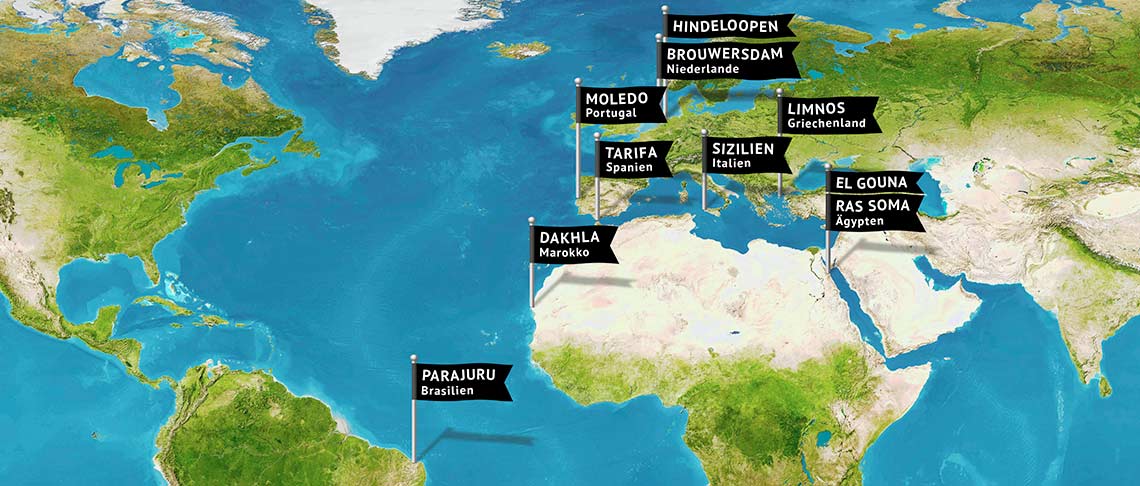All Beginner Courses at KBC
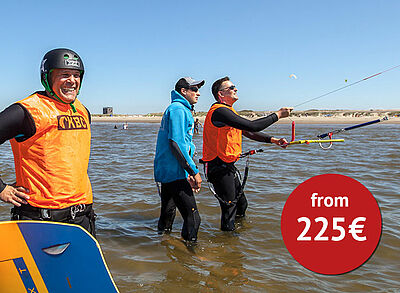
Brouwersdam at the North Sea (NL)
from April to October
You learn to kitesurf at shallow depths at the Brouwersdam on the Dutch North Sea beach, e.g. in a 10-hour basic course.
the kite school at Brouwersdam
Kitesurf Course from 225€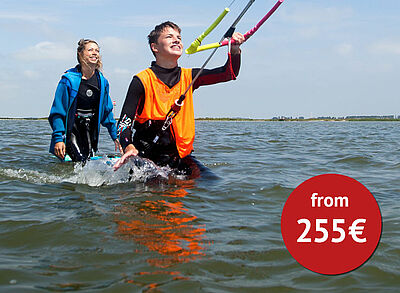
Workum/ Hindeloopen at the Ijsselmeer (NL)
from April to October
You learn to kitesurf in the huge standing area on the Ijseelmeer near Hindeloopen and Workum, e.g. in a 10-hour basic course.
the kite school at the Ijsselmeer
Kitesurf Course from 255€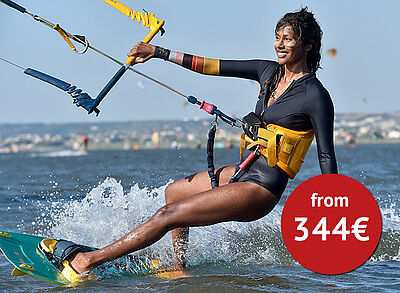
Lo Stagnone on Sicily in Italy
from April to October
You learn to kitesurf in the huge, completely shallow Lo Stagnone lagoon in Sicily, e.g. in an 8-hour basic course.
Kitesurf Course from 344€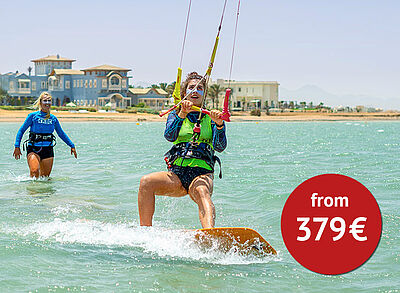
El Gouna at the Red Sea in Egypt
all year round
You learn to kitesurf in the large shallow private kite lagoon, e.g. in the 8-hour basic course.
Kitesurf Course from 379€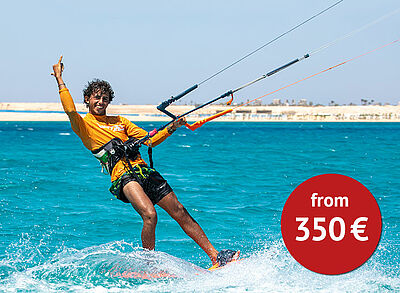
Ras Soma on the Red Sea in Egypt
all year round
You learn to kitesurf in the large bay of Ras Soma, e.g. in a 6-hour basic course with a maximum of 2 people.
Kite course from 350€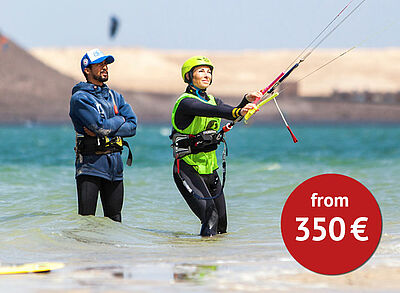
Dakhla in Morocco
all year round
You learn to kitesurf in the shallow area of the huge lagoon of Dakhla, e.g. in the 8-hour basic course.
Kite course from 350€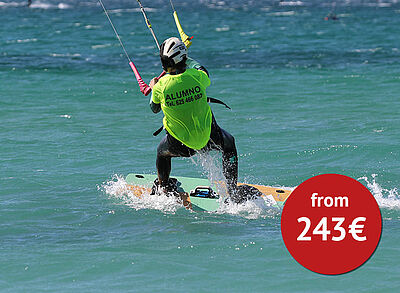
Tarifa in Spain
from March to November
You learn to kitesurf in deep water via radio training, e.g. in the 9-hour basic course.
Kitesurf Course from 243€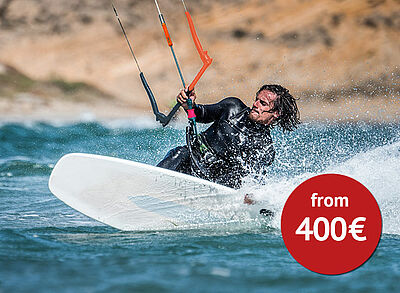
Limnos in Greece
from June to September
You learn to kitesurf in the huge lagoon at Keros Beach on the Greek island of Limnos, e.g. in an 8-hour basic course.
Kitesurf Course from 400€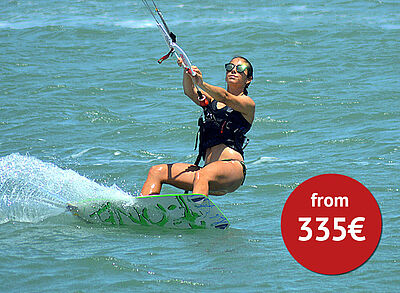
Parajuru in Brasilien
from July to January
You learn to kitesurf in the large shallow lagoon in Parajuru, e.g. in the 8-hour basic course.
Kitesurf Course from 335€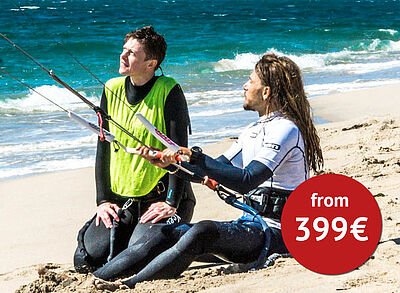
Moledo/Caminha in Portugal
from May to October
You learn to kitesurf in deep water on the Atlantic Ocean in Portugal, e.g. in an 8-hour basic course.
Kitesurf Cours in Portugal at Moledo at KBC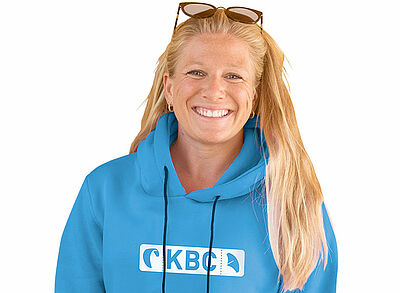
Where to go?
You don't know which spot is best for you and still have questions?
Isabelle will be happy to advise you:
+49 211 83832780 (Mo-Sa 9am - 6pm)
Can I learn kitesurfing?
You have often stood on the beach and watched the kite in the sky, wondered why the lines don't tangle, or watched action videos and big air contests. And you wonder if you could learn to do the same.
The answer is quite simple: Yes!
You want to learn kitesurfing too? And preferably fast and safe? Thanks to constant innovations in the development of kitesurfing equipment, kitesurfing has become a safe sport over the last decades, which you can learn quickly and easily. You will be rewarded by the indescribably beautiful feeling of gliding over the water, which has a high addiction factor.
Which physical conditions help?
We would almost like to claim: Every active person, no matter if man or woman, can learn kitesurfing. If you feel fit, you can't be too young or too old for kiting. Our oldest kitesurfing student in Egypt learned kitesurfing at the age of 78.
- You should have good motoric skills and a healthy self-confidence.
- Your body weight should be at least 35kg, because especially in stronger winds you should have enough counterweight.
- As with all water sports, you should be able to swim and stay afloat for at least 15 minutes, and you should be able to swim in open water, in the sea or on lakes.
Do I need much strength when kitesurfing?
Even though it looks like it. But: For kitesurfing you don't have to expend a lot of power or muscle effort - it's more about practicing a technique that doesn't require a high application of force. Kitesurfing requires much less power than windsurfing, surfing or wakeboarding, because when kiting you wear a harness that distributes the power of the kite over your entire body. So you don't necessarily have to be well trained, physically super fit and muscular for kitesurfing. A normal fitness level is absolutely sufficient.
Experienced kitesurfers can easily cruise for hours on end over the water with only moderate exertion. Only when you practise jumps or freestyle tricks will your fast forces in arms and legs and especially the back and abdominal muscles be challenged. Only after your first attempts at jumps will you be surprised by sore muscles after your kite session.
...and previous knowledge?
To learn kitesurfing you do not need any previous knowledge. However, it helps if you have already dealt with wind (e.g. kite flying) or board sports (e.g. wakeboarding, snowboarding, surfing, windsurfing).
But even without experience you will achieve fast learning success.
Can I learn to kite if I wear glasses?
As a person wearing glasses, you probably often wonder whether you can still handle your glasses in the water when you are moving around. That is also the case with kitesurfing. The spray water constantly makes your glasses wet or even rinses them off your face. But don't worry, there are simple solutions for this. We recommend contact lenses for low vision, which experience has shown to keep a good eye on water sports. Possible losses and the salt water make daily lenses more suitable than the slightly more expensive monthly lenses.
Kitesurfers like to wear sunglasses to protect their eyes on the water from the strong UV radiation, but also from splash water. Polarizing lenses make vision even better. You can find suitable sunglasses at every KBC center. As an alternative to contact lenses, sunglasses with prescription are also a good choice for you as a wearer of glasses. These should be fastened with an elastic strap to prevent loss. You can find sunglasses with prescription at any optician. We offer the elastic bands, which you can purchase in every KBC kite school.
Is kitesurfing dangerous?
The prejudice "kitesurfing is dangerous" is fortunately not correct. Kitesurfing has developed in recent years through technical development of kite equipment to a sport that is by no means more dangerous than other outdoor sports. However, you should master the technique, use common sense and not overestimate yourself. At the same time you must always be aware that you are working with two forces of nature at the same time - wind and water, which you should know well and never underestimate. If you want to learn kitesurfing, you should definitely take a professional kitesurfing course, otherwise kiting can be very dangerous.
In your kitesurfing course you will learn, besides kitesurfing theory and riding technique, a lot of things that are extremely relevant for your safety, such as material knowledge, the appropriate kite size for the right wind, assessment of wind and weather conditions, professional construction of the material, safe launching and landing, the use of the internationally valid hand signals, right of way and general rules on the water.
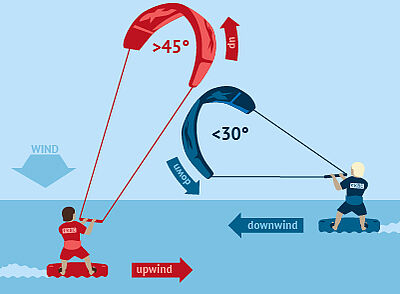
Safety with right of way rules
Which kitesurfer has priority? You should know all the priority rules, info and regulations when kitesurfing.
to avoid accidents and collisions in the kitesurfing area. This ensures safety and ease of traffic on the water.
Can I learn kitesurfing without a course? Or can I teach myself to kite?
It is of course absolutely NOT advisable to try to teach yourself to kitesurf. The sport is simply much too complex and there is a lot to consider. Even if you are already an expert in other board sports, kitesurfing is all about kite and kite control and much less about board skills. Therefore it is also essential for you as a board expert to take a kite course.
Without the necessary knowledge in theory and experience in practice, you can put yourself in great (life) danger if you handle the kite improperly. You are also a safety risk for all other people on the beach and on the water. A kitesurfing course at a professional, licensed kitesurfing school is therefore absolutely necessary and highly recommended.
Can I prepare for my kitesurfing course?
If you have booked a kite course and can't wait, it is very understandable that you want to do something to prepare them. We recommend that you read and read a book about kitesurfing: the work and style book from VDWS, the accompanying course book, which partly contains the theoretical basics of your kite course.
Flying exercises with a trainerkite also bring much experience and fun. This is a small kite with a maximum of 2qm (in no case a power kite). Look for a place on land with a little bit of non-swirling wind and a lot of space, e.g. a big meadow. Practise keeping the trainer kite in one place and then fly controlled eights. This will give you a good feeling for the flight and turning behaviour of the kite. The faster you will make progress with the kite control in the course.
It is also worth keeping yourself generally fit.
Where is the best spot to learn kitesurfing?
To learn kitesurfing, you should choose a spot that has very easy conditions suitable for beginners. Absolutely ideal conditions for beginners are flat water, no waves, shallow water, plenty of space, a constant, medium wind and pleasant temperatures. So you will not be distracted by anything and can concentrate completely on your kite, your kite instructor and learning to kite. If the water is shallow, i.e. maximum hip-deep, you will always have solid ground under your feet and can easily walk back to the starting point of your exercises (without having to swim), because the kite will often pull you downwind (the side facing away from the wind).
However, it is important to practice or simulate the action in deep water during the training in the standing area, so that the change to deep water is not so difficult and you are prepared for the demands of launching, landing, releasing and kitesurfing in deep water.
Some spots (e.g. KBC Tarifa) are not exclusively standing areas. Here the kitesurfing courses take place swimming or by boat training. This has the big advantage that the kitesurf student is not surrounded by solid objects or obstacles where he could get injured. The communication with the kitesurfing instructor is done here by radio using a headset.
The temperatures should not be too low, because in the beginning you are standing a lot in the water. If you freeze too fast, you lose energy and your training sessions will be shorter. So the choice of the spot depends on the temperatures and the wind and therefore on the season.
Winter and spring:
- El Gouna at the Red Sea in Egypt (all year round)
- Ras Soma at the Red Sea in Egypt (all year round)
- Dakhla in Morocco (all year round)
- Parajuru in Brazil (end of July til the end of January)
Spring to autumn (April to October):
- Hindeloopen at the Ijsselmeer in the Netherlands
- Brouwersdam at the Ijsselmeer in the Netherlands
- on the island Sicily in Italy
- on the island Lemnos in Greece
- Tarifa in Spain
- Caminha in Portugal
- El Gouna in Egypt (all year round)
- Ras Soma at the Red Sea in Egypt (all year round)
- Dakhla in Morocco (all year round)
Learn kitesurfing in the beginner course
A course of a classic basic course at Kiteboarding Club
All offers for kitesurfing beginner coursesThis course is perfect for anyone with previous experience in water sports, snow sports or wind sports and/or for gifted fast-learning individuals. For those who have limited to no previous experience or who simply want very thorough training, we recommend the Intensive Basic Course. The Basic Course consists of 8 hours in a group, spanning over 2-3 days of lessons, depending on conditions. Students will learn the essential elements of kitesurfing in groups of 2 to 6 people. In order to practice and to master the techniques, the second part of the course allows for plenty of practical training time. The aim of the course is to enable you to practice safely on your own after the course.
Contents:
- Introduction to the equipment (boards, 4-line delta kites)
- Kite setup Safety procedures (Land & Water)
- Kite flying exercises Fundamental theory
- Water start of the kite (Re-launch)
- Body drag - downwind and upwind
- Board work - doing the water start
- The first meters of riding downwind...
How many participants does a kite course have?
The Kiteboarding Club trains in different course sizes, all of which have proven themselves in practice:
basic course
The basic course takes place with 4 students and a teacher, whereby 2 students initially share one kite. The kitesurfers share one kite at the beginning to be able to secure each other and to be able to rest and relax between their sessions. The kite control requires a high level of concentration and attention in the beginning. At kite spots like El Gouna, where the conditions are excellent and safe, with shallow water and very constant wind, the training can also take place with 6 students and a kite instructor.
individual training
Those who like it a little bit more private or want a very individual learning pace, choose a training in pairs or even in individual supervision. Your private kite instructor will take care of you exclusively, and can respond even more intensively to your personal needs.
camp/event
If you are looking for a time-intensive course and want to learn everything about the world of kitesurfing, choose the camp at KBC Holland or the events at KBC El Gouna or KBC Sicily. Here the students spend 4 or 7 days together in a group and learn everything about kitesurfing - from material science, self-rescue, meteorology and intensive riding techniques - in addition to kitesurfing, riding technique or new tricks.
How long does it take before you can kite?
In a 2-3 hour taster course you will get a first brief insight into the sport. This is a good choice if you are not yet so sure. But after a taster course you are far from being ready. You should book a kitesurfing course of at least 8 hours, better still 12 hours. This takes place on 2-3 days. Some centers also offer weekend camps or one-week events - also a very good choice. After the course you should definitely plan some free practice time, because only a practical consolidation of what you have learnt will allow you to learn kitesurfing in depth.
We recommend to plan at least one week for learning kitesurfing. A short holiday is of course very suitable for this. This way you will have enough time to practice the basics - like handling the kite, launching and landing waterstart, the first meters of riding, possibly turning - safely and in different conditions. The investment of more time is of course always recommended. As kitesurfing is a nature sport and depends on the weather, tide and wind, it is possible that there might not be suitable conditions for kitesurfing in your week.
You will be very proud once you have successfully completed the first 20-30 meters. What an indescribably beautiful feeling to glide over the water! This is the beginning of a beautiful (but also long) way. Now it is time to gain experience to become a completely independent kitesurfer, who can kitesurf safely in any conditions and has everything under control. A little patience and a lot of practical training time, because every minute on the water with the kite helps and takes you further.
Where can I find the best kite school?
The Kiteboarding Club you are lucky to learn at a renowned German kitesurfing school, which has been teaching kitesurfing professionally since 2000. The training concept, developed by the sports scientist and founder Thomas Beckmann, has proven itself since then and is practiced at eight kitesurfing schools worldwide. Many of the KBC kitesurfing instructors have a degree in sport and are therefore highly qualified beyond the VDWS kitesurfing instructor training. Most of them have been active in the KBC network for many years and alternately work as kite instructors or station managers at several KBC spots. Competence, friendliness and readiness for action is the maxim. They love what they do and are happy to share their learning success with the students. They can also easily respond to individual requirements. The KBC is considered a forge for young kite instructors. The kite instructors who have been trained at the KBC are in great demand at all kite centres. The kite school often gets special praise for the familiar atmosphere and the great atmosphere: A relaxed Easy Going, but at the same time a perfect organisation in the background.
Almost all KBC kite schools teach in German, only at KBC Dakhla and KBC Tarifa you will find only English speaking kite instructors. At all KBC centers, we also teach in English, some of them also in French and Arabic on request. You should make sure that your kite instructor speaks a language that you understand 100%.
Kitesurf Equipment
Since 2005, the Kiteboarding Club has been teaching with kites and boards of the premium brand F-ONE. The well-known kite "Bandit" has been giving every student a safe start into kitesurfing for many years in our kite schools, but also beginners and professional kitesurfers are enthusiastic about its excellent characteristics. Your kite instructor will show you how to handle the kite in the first lessons. The Bandit lets you easily relaunch (start from the water), depower (adjust the power of the kite) and ride upwind.
The kites at the KBC centres are renewed every year. Brand new kites, the current year's kites or preview models are included in "Premium Rental", last year's kites in perfect condition are included in "normal rental". The kites are serviced daily and only kites in perfect condition go to the training. At all KBC kite schools, you will receive a wetsuit to keep you warm in the water for free. At some centres, the rental of neoprene shoes is also free of charge or they can be bought in the shop on site. High quality is also very important here.
For your KBC kiting course, you will be provided with a long Neoprene suit (with the exception of KBC El Gouna in midsummer). This keeps you warm and protects your skin. Neoprene shoes protect your feet from rocks, surface irregularities and hypothermia. Most KBCs include the hire fee for these shoes along with the course. The Seat harness makes it easier for you to hold your kite. During the course, your instructor will help you familiarise yourself with all of the harness’s safety features. In warm regions, instead of the neoprene suit you’ll wear board shorts and a Lycra® shirt. It protects you from UV radiation and makes you more visible on the water.
In very sunny regions we recommend wearing Water sports glasses. You can purchase these in advance from the KBC Shop or at the on-site KBC shop. Sun protection is an absolute must on the water. The sunscreen you choose should be waterproof and wear-resistant, like Island Tribe Clear Gel, which is available directly from the KBC.
The course fee includes hire of your kiting gear: a kiteboard suitable for beginners, the kite bar, the kite und the leash. Your kitesurf instructor will explain all you need to know about the material and construction.
How many wind forces and what wind warranty do I need to learn to kite?
Wind and a high wind yield are essential to learn kitesurfing. Without wind the kite will not fly and you can only finish the theory and material part of your kitesurfing course. KBC kitesurfing schools can be found in areas where windless periods are rare. The wind force for learning to kitesurf should be in the range of 12 to 25 knots. The stronger the wind, the smaller the kite size.
Do I need a kitesurf licence?
After your course you have the possibility to acquire the kitesurfing license after an exam. This is compulsory for kitesurfers at some kite spots, a measure taken by local clubs and communities to ensure safety on the water. If you want to rent kite equipment at a kitesurfing school, in most cases you will also need to present a kitesurfing licence with the appropriate level. In this way you guarantee the kiteshop that you have mastered the professional handling of the kite material.
Is kitesurfing expensive?
The entry into kitesurfing is not expensive. At KBC in Holland you can book a 10-hour basic course for just 225€. Accommodation at the campsite is also affordable. If you enjoy kitesurfing, you want to spend more time with your new hobby and you plan to buy your own equipment, there are some costs involved, but with the necessary know-how you can keep them low and you can get by on a small budget.
It is not uncommon for kitesurfing students to be seized by kite fever right after the first course and since then they have devoted their entire free time to this new sport. Then of course the travel costs will also be your responsibility. You can kitesurf all year round, so theoretically you can use your entire annual holiday for it. Good equipment includes 2 to 3 kites, a board, a harness, a pump and a wetsuit. If you buy all of them new you will quickly land up with around 4000€. Before buying too quickly, we recommend that you test them thoroughly and consider buying slightly used but perfectly maintained kites and boards from KBC rental. You can test all kite sizes and board models for free at KBC. The KBC instructors will give you extensive advice. Please keep your hands off used kite material on eBay. You don't know the previous owner, don't have the necessary idea what to look out for and buy material blindly, but you should trust it blindly on the water.
At the beginning it is certainly the cheapest way to rent kite equipment:
Kitesurf Equipment mieten statt kaufen?
You don't need immediately your own gear. And even if you already have a kite and board, you should consider leaving your own equipment at home and renting kites and boards from KBC. This doesn't have to be much more expensive - for comparison: With one week storage/service (78€) and kite luggage transport (e.g. Condor 110€) you only pay 181€ more if you rent equipment at KBC for one week (369€). The longer you rent, the cheaper the daily price.
By choosing rental equipment you save yourself carrying heavy loads, save your own equipment and have the free choice from all kite sizes and board types and sizes and you can always ride the very latest equipment, the current board and kite range. And should the wind not be right, you will get the rental price refunded in form of a voucher.
Learn kitesurfing with friends and family
Kitesurfers – and this is really amazing about this sport – are never alone, because kitesurfing is a very sociable sport. In a kitesurfing course you quickly get to know the other course participants. On the beach while setting up the kites, while launching and landing each other's kites, you get into conversation very quickly and after the session everyone chats about the kite day. The kite fever sets in and often the enthusiastic kiter brings his friends and family to kitesurfing.
You can learn kitesurfing together with your partner or friends. You spend a great time on the water, learn something together, can exchange experiences and gain a new common passion for life. If you haven't yet been able to convince your partner of the value of a kitesurfing course, let him/her do a taster course first.
Kitesurf holiday plus...
In your holiday you can also combine kitesurfing with other great activities:
- Kitesurfing & yoga
at KBC El Gouna and KBC Dakhla - Kitesurfing & horseback riding
at KBC El Gouna and KBC Parajuru - Kitesurfing & snorkeling
at KBC El Gouna and KBC Ras Soma - Kitesurfing & diving
at KBC El Gouna and KBC Ras Soma - Kitesurfing & surfing waves
at KBC Dakhla, KBC Tarifa and KBC Portugal - Kitesurfing & SUP
at KBC El Gouna, KBC Dakhla, KBC Sicily, KBC Tarifa and KBC Portugal - Kitesurfing & mountainbiking
at KBC Dakhla, KBC Portugal and KBC Tarifa
Kitesurfing with kids
Children and kitesurfing are not mutually exclusive. Families with children of all ages meet regularly at the KBC centres. For the very young ones, KBC offers a babysitting service (e.g. at KBC El Gouna, KBC Dakhla or KBC Tarifa), while for the older ones there are great play facilities, such as a lovely playground at KBC El Gouna and the campsite at KBC Brouwersdam. At KBC El Gouna, KBC Ras Soma, KBC Limnos, KBC Dakhla and KBC Parajuru there are wonderful swimming pools with children's areas. Accommodation in all KBC destinations offers great family accommodation.
And at some point, you may ask yourself, "When will my child be old enough to learn to kitesurf? There's no general answer to that question. But the following conditions should be fulfilled:
When can children start to learn kitesurfing?
- Your child's motoric skills and general physical development should be good.
- Your child should have the will to learn kitesurfing, he should have the ambition to fly the kite himself.
- It should show not only the courage but also the necessary respect for the sport.
- Your child should have the maturity to assess a situation correctly and always keep a cool head and control.
- The wind and water conditions on site must be suitable. KBC Holland on the Ijsselmeer, for example, and especially in the shallow lagoon of KBC El Gouna, offers training.
- The wind should not be too strong, ideally between 12 and 16 knots.
- The right equipment is available at the Kiteboarding Club, children's harnesses, children's neoprene, small boards and kites in the smallest sizes.
The kids course at KBC
At the Kiteboarding Club we train children from the age of about 10 years. After a previous assessment, we always start with individual supervision, so that the little student can be given full attention. The training units are suitable for children with many short, practical exercises, playful and vivid.
The training for children starts with 3 hours participation in the normal basic course with a small theory unit, a spot check, kite assembly and disassembly, 3-step safety system and trainer kite flying. The further part follows for safety reasons in 3 hours of individual supervision - 1.5 hours each per day.
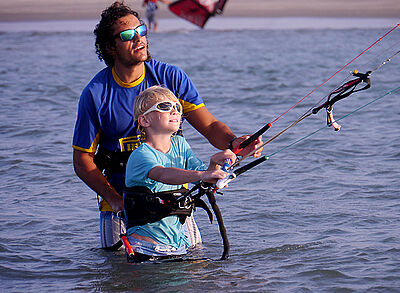
Kitesurf lessons for kids
Children's courses are available at all KBC kite centres. Just ask the center when you make your booking.
Children's course at KBC Brouwersdam for €280Which is the best place to learn kitesurfing?
The easiest way to start your first kitesurfing course is of course very close by. If you live close to the Northern Sea and the Netherlands, the two KBC centres in the Netherlands are ideal for this: the KBC Hindeloopen on the Ijsselmeer or the KBC Brouwersdam on the North Sea. You learn in the standing area with a usually very good wind yield. On all weekends and also in the week between April and the end of October you can do your kitesurfing course here. Both centers are connected to wonderful campsites where you can stay cheap and creative.
Ideally, you have already done your first course in Holland and can use your first kitesurfing holiday for a refresher course or directly the first few metres of riding.
However, it is also possible to spend at least a one week's holiday at one of the other KBC destinations abroad. Here you will have time and ideal conditions to concentrate fully on learning to kitesurf during your holiday. Here you will find all destinations for your kitesurfing course:
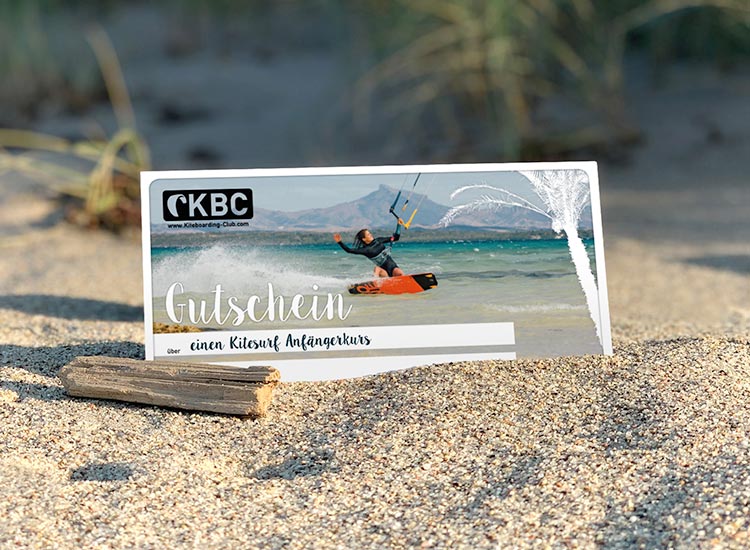
Kitesurf Gift
Give the gift of an unforgettable experience! The perfect gift for spending time together learning to kitesurf with a kitesurfing voucher or a value voucher for the KBC Kitesurf online shop.
Choose a kitesurf gift voucher.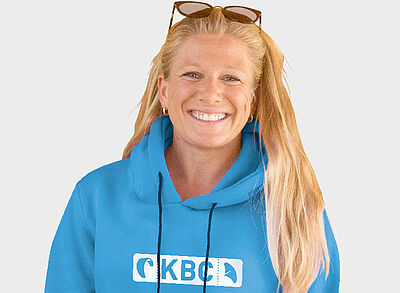
Advice
You have general questions about kitesurfing, you don't know which course suits you best and you would like some advice?
Isabelle is happy to advise and help you:
+49 211 83832780 (Sun-Fri 9am-5pm)
travel@kiteboarding-club.com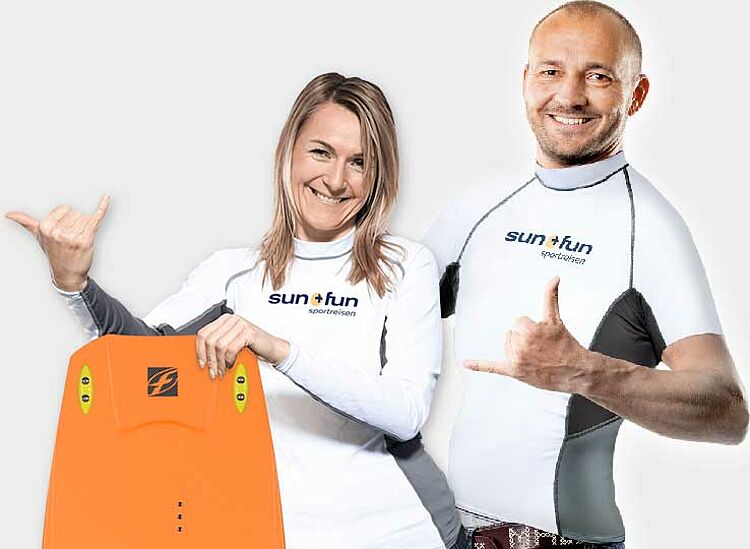
Travel offer from the experts
Are you looking for a complete package with flights, accommodation and kite services?
The sun + fun team is our competent partner for sport holidays worldwide. They will tailor-make your holiday with additional services such as sports, rental cars and more at the best price. saf@kbc-world.com
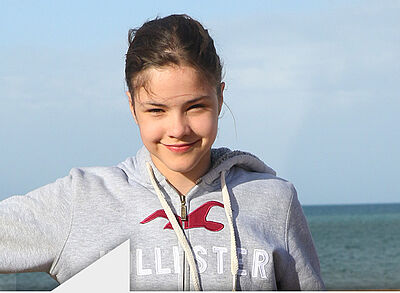
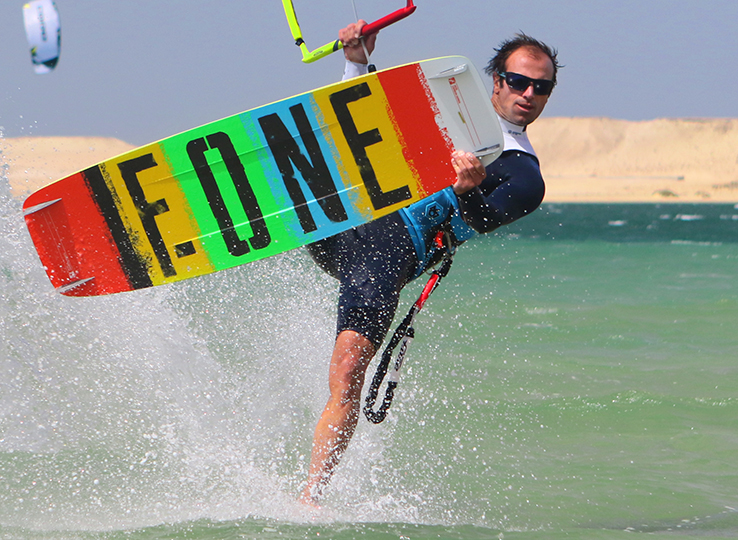
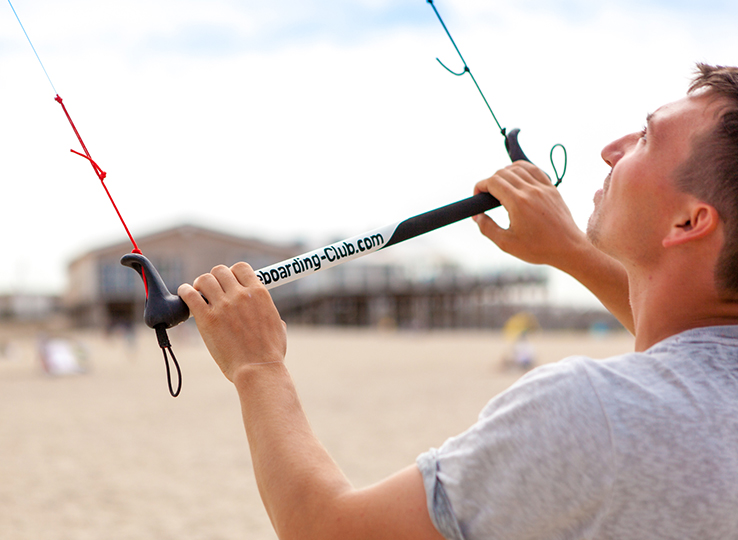
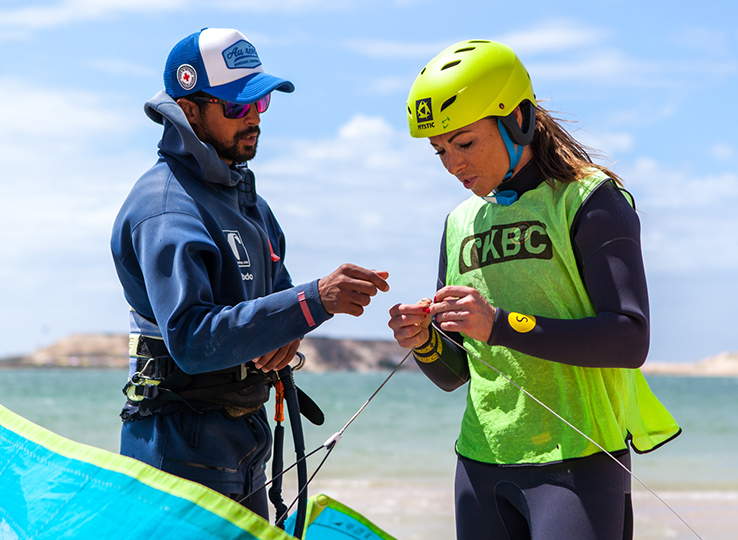
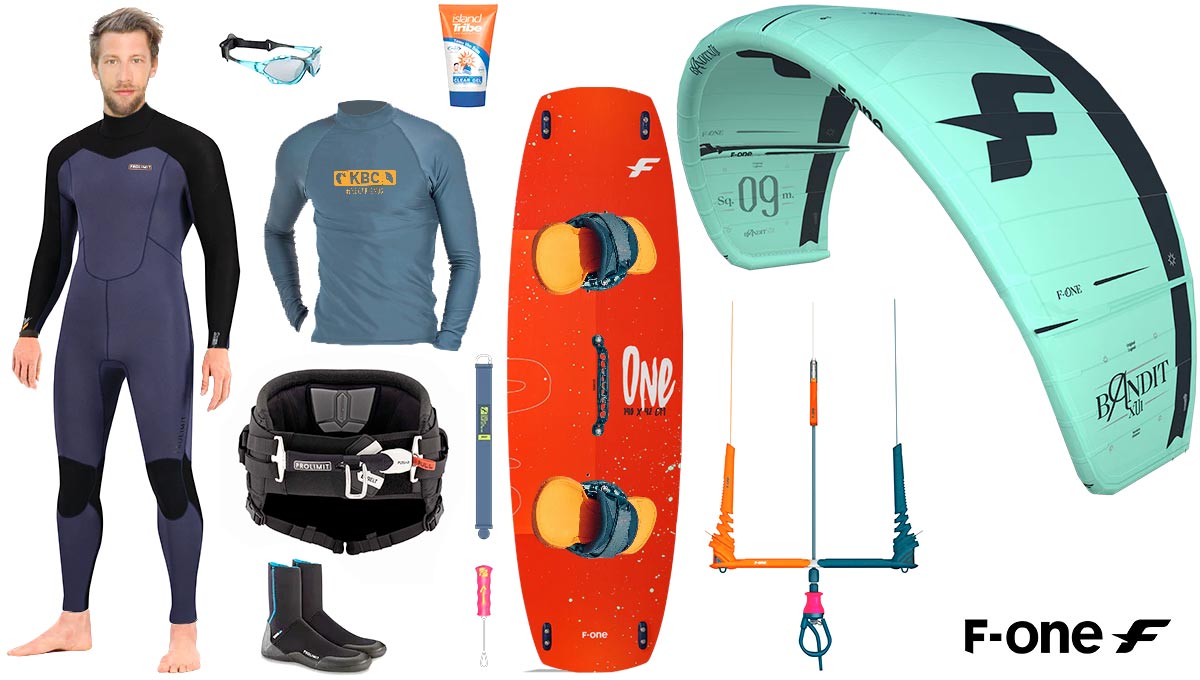
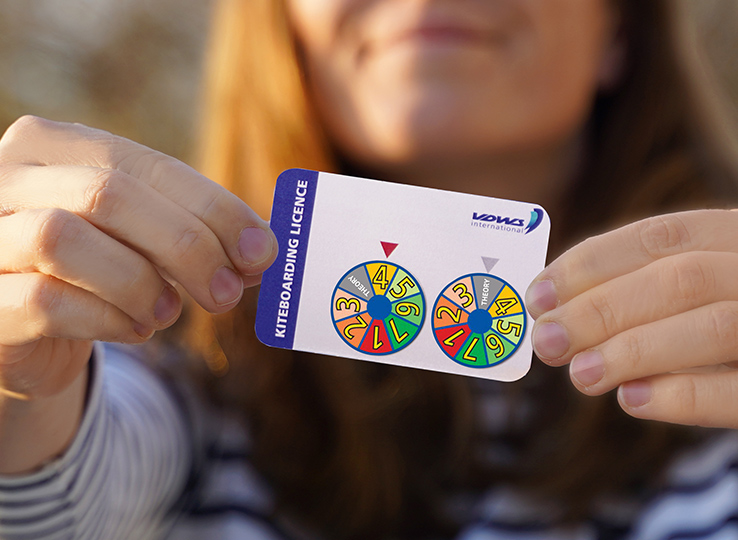
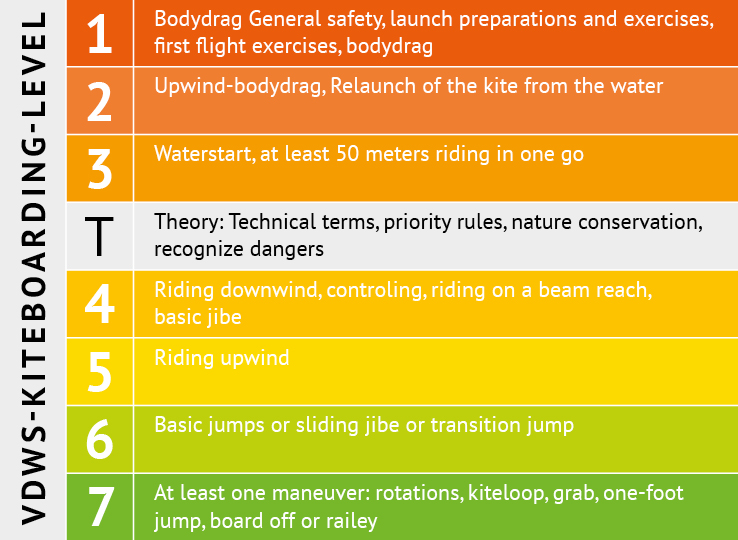
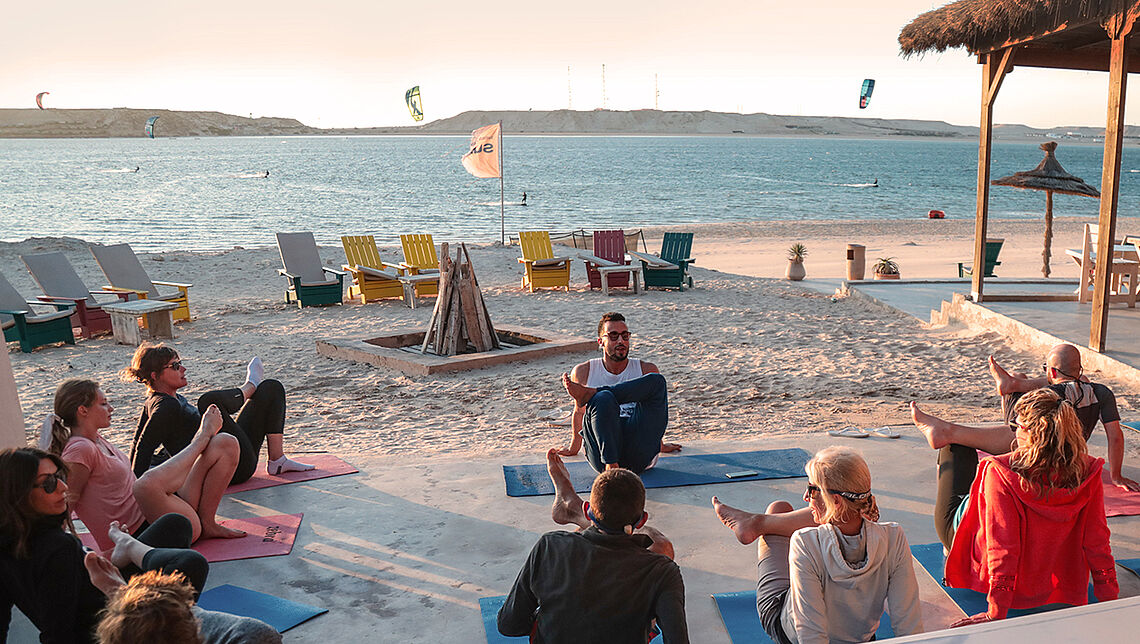
![[Translate to english:] Kitesurfen mit Kindern und Familie am Kiteboarding Club](/fileadmin/user_upload/Contentpictures/Kitesurfen_lernen/Kitesurfen_mit_kinder_am_KBC.jpg)
